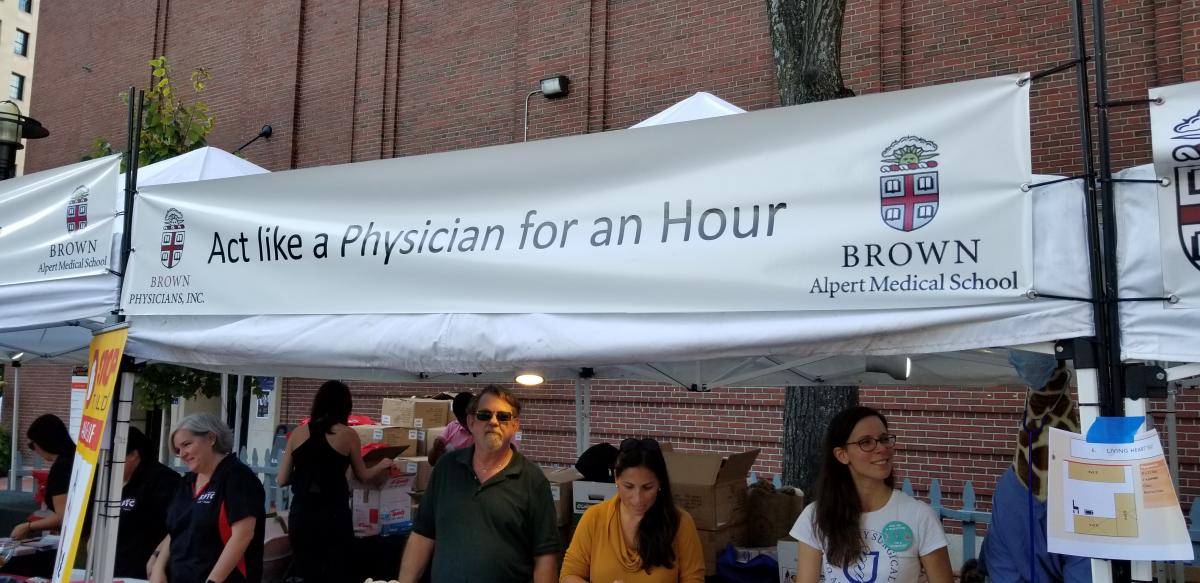Check out some of the neuroscience featured events at the 2nd Annual Big Bang Science Fair:

Tent Elizabeth Blackwell: Act like a Physician for an hour
Time: 5:00 PM-10:00 PM
5:00-6:00 PM Brown Neurology physicians will be available to administer and interpret Fun Brain Games for adults and children
6:00-7:00 PM Brown Emergency Medicine physicians from the Injury Prevention Center will be on hand answering questions about bike helmet and car seat safety and supervising CPR demos
7:00-8:00 PM Brown Dermatology physicians will be available to answer questions and demonstrate laboratory microscope technology
8:00-9:00 PM University Surgical Associates trauma physicians will focus on an interactive teaching display of their “ Stop the Bleed” program, including Tourniquet kits, practice Dummies and working on volunteers/visitors.
Tent Rita Levi Montalcini: Neuroscience in Action!
Time: 5:00 PM-10:00 PM
Experience the mysteries of the brain and nervous system through a series of hands-on activities and demonstrations. Build your own neuron! Measure electrical responses from the nervous system! Understand the mysteries behind optical illusions! Explore the anatomy of the human brain! And more! Activities early on in the afternoon will be geared towards our younger scientists, while activities later in the evening will become more complex.
6:00 pm Lecture: John Donoghue (Brown University) “Merging Man and Machine to help people with Paralysis”
 The brain is the most complicated structure in the universe. Through our senses, our brain receives a view of the outside world, stores it, changes it, creates moods, feelings and behaviors- a mysterious kind of computing with a mysterious code ‘spoken’ by millions of brain cells. Brain cells called neurons speak to each other through a giant, messy network of connections that is the hardware able to turn your thoughts into actions. When the brain is altered by disease or injury the results can be devastating: paralysis, blindness, depression, epilepsy. But now it is becoming possible to use technology to fix the broken brain. At Brown University researchers have developed BrainGate, a “brain computer interface” (BCI) that uses brain sensors and electronics to reconnect the brain to machines for people how are paralyzed, allowing them once again to communicate through a brain-controlled computer or even to move their own body again through electronic links commanded only by thinking. I’ll show videos of what people with paralysis can do now using BrainGate, how the connection between the mind and machines could develop in the future, and how BCIs might challenge our view of the boundaries between humans and intelligent machines. Professor Donoghue is a neuroscientist best known for having developed an innovative brain-computer interface to restore movement for people with paralysis. He founded the Brown Institute of Brain Science, Brown University. He also holds an adjunct professorship at the École Polytechnique Fédérale de Lausanne (EPFL) and is a visiting professor at the University of Geneva in Switzerland. Professor Donoghue was also a co-founder of an early neurotechnology startup company, Cyberkinetics
The brain is the most complicated structure in the universe. Through our senses, our brain receives a view of the outside world, stores it, changes it, creates moods, feelings and behaviors- a mysterious kind of computing with a mysterious code ‘spoken’ by millions of brain cells. Brain cells called neurons speak to each other through a giant, messy network of connections that is the hardware able to turn your thoughts into actions. When the brain is altered by disease or injury the results can be devastating: paralysis, blindness, depression, epilepsy. But now it is becoming possible to use technology to fix the broken brain. At Brown University researchers have developed BrainGate, a “brain computer interface” (BCI) that uses brain sensors and electronics to reconnect the brain to machines for people how are paralyzed, allowing them once again to communicate through a brain-controlled computer or even to move their own body again through electronic links commanded only by thinking. I’ll show videos of what people with paralysis can do now using BrainGate, how the connection between the mind and machines could develop in the future, and how BCIs might challenge our view of the boundaries between humans and intelligent machines. Professor Donoghue is a neuroscientist best known for having developed an innovative brain-computer interface to restore movement for people with paralysis. He founded the Brown Institute of Brain Science, Brown University. He also holds an adjunct professorship at the École Polytechnique Fédérale de Lausanne (EPFL) and is a visiting professor at the University of Geneva in Switzerland. Professor Donoghue was also a co-founder of an early neurotechnology startup company, Cyberkinetics